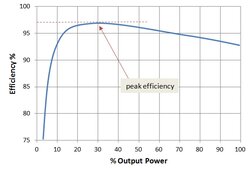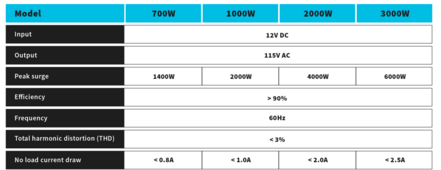arielbalter
New Member
I tried searching the internet, and everything I found was about using inverters in parallel seemed to be for coordinating multiple inverters supplying to a single bus. I'm curious about using multiple inverters with different power ratings for circuits that will have different loads.
I'm building an all-electric, off-grid system for a tiny house. There are a few things that draw a lot of power intermittently: Induction burner, oven, on-demand water heater, etc. Everything else is low-power.
With a large inverter the draw would be far below the efficient range of operation the vast majority of the time. At least, I've found this image in multiple places on the internet, such as [here](https://www.e-education.psu.edu/eme812/node/738):

Rather than a using a single 6000W inverter and only drawing enough power for lights, laptop, and refrigerator 90% of the time, I was wondering if I could, instead, use multiple smaller inverters in parallel (as shown below)? Also, since each inverter would have its own switch and fuse, I wouldn't really need a breaker panel.
This would not require coordination between the inverters. I don't see why it would, in principle, create an excessive load on the batteries compared to a single inverter at the maximum draw.
Am I missing something?
I'm building an all-electric, off-grid system for a tiny house. There are a few things that draw a lot of power intermittently: Induction burner, oven, on-demand water heater, etc. Everything else is low-power.
With a large inverter the draw would be far below the efficient range of operation the vast majority of the time. At least, I've found this image in multiple places on the internet, such as [here](https://www.e-education.psu.edu/eme812/node/738):

Rather than a using a single 6000W inverter and only drawing enough power for lights, laptop, and refrigerator 90% of the time, I was wondering if I could, instead, use multiple smaller inverters in parallel (as shown below)? Also, since each inverter would have its own switch and fuse, I wouldn't really need a breaker panel.
This would not require coordination between the inverters. I don't see why it would, in principle, create an excessive load on the batteries compared to a single inverter at the maximum draw.
Am I missing something?
Code:
+---------+
------| |---+------------------+
2.5A | 300W | | |
------| 120VAC |---------+ |
+---------+ | | |
| | |
| | |
| | |
+---------+ | | |
------| |---+ | |
2.5A | 300W | | | |
------| 120VAC |---------+ ----
+---------+ | | ---------
| | ----
| | --------- 12 V
| | ----
+---------+ | | ---------
------| |---+ | |
15A | 2000W | | | |
------| 120VAC |---------+ |
+---------+ | | |
| | |
| | |
| | |
+---------+ | | |
------| |---+ | |
30A | 4000W | | |
------| 120VAC |---------+-------------+
+---------+
Last edited:




